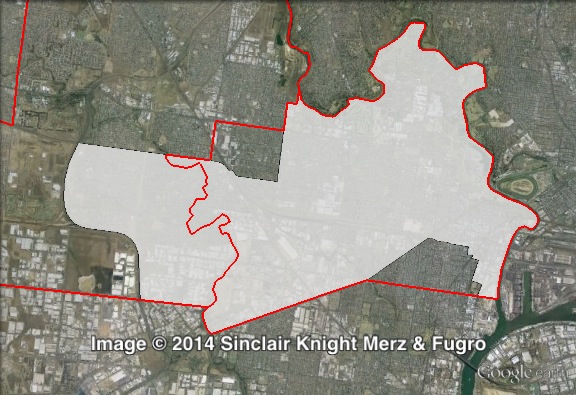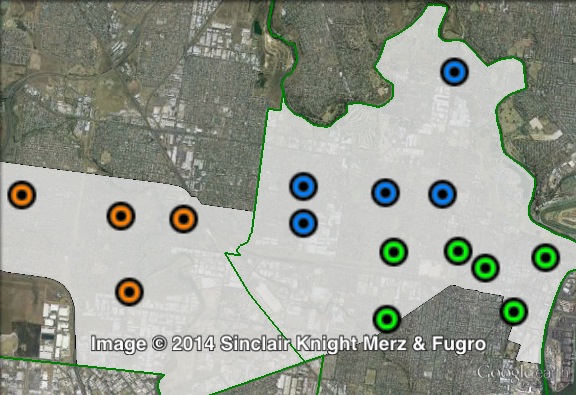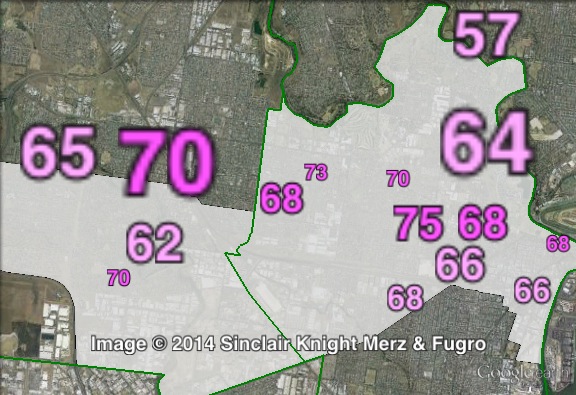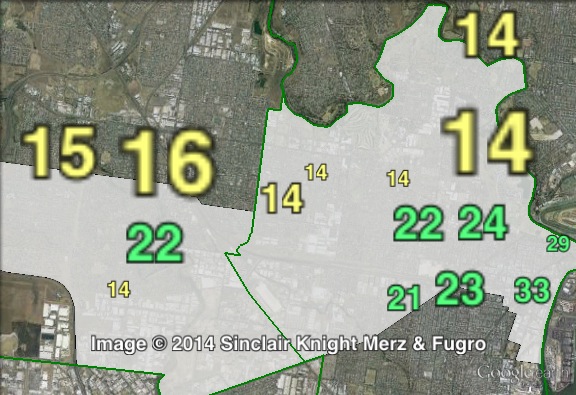ALP 15.9%
Incumbent MP
Marsha Thomson, since 2006.
Geography
Western Melbourne. Footscray covers a majority of the City of Maribyrnong and the southeastern corner of the City of Brimbank. The seat covers the suburbs of Braybrook, Footscray, Maidstone, Maribyrnong, Tottenham and West Footscray and parts of Brooklyn, Sunshine and Sunshine West.

Redistribution
Footscray lost Kingsville and Seddon to Williamstown, and parts of Sunshine to St Albans. Footscray gained Sunshine West from Derrimut. These changes cut the Labor margin from 16.2% to 15.9%.
History
Footscray has existed in its current incarnation since 1927, and in that time it has always been held by the ALP. It had previously existed from 1877 to 1904.
Footscray was first won by George Prendergast in 1927. He had been one of the first Labor members of the Victorian parliament when he won the seat of North Melbourne in 1894. He held it until 1897 and again from 1900 to 1926. Prendergast had served as the first leader of the Victorian ALP and as Premier for six months in 1924. He died in office in 1937.
The ALP’s John Mullens won Footscray at the 1937 electon. He held the seat until 1945. He later went on to serve as federal member for Gellibrand from 1949 to 1955, when he left the ALP as part of the split that created the Democratic Labor Party.
In 1945, John Holland (also of the ALP) transferred from the seat of Flemington, which he had held since 1925. He served as Member for Footscray until 1955, when he returned to the seat of Flemington. He died six months after the 1955 election.
Footscray was won in 1955 by Roy Schintler, who moved three years later to the seat of Yarraville, holding it until his retirement in 1967.
Alfred Shepherd moved to the seat of Footscray at the 1958 election. He had held a number of other seats since 1945, but died only months after the 1958 election.
The 1958 by-election was won by William Divers, who held the seat until 1970. Footscray was held from 1970 to 1992 by Robert Fordham, who served as deputy leader of the ALP from 1977 to 1982.
Footscray was won in 1992 by the ALP’s Bruce Mildenhall, who held the seat until his retirement in 2006. He was succeeded in 2006 by Marsha Thomson, and Thomson was re-elected in 2010.
Candidates
- Rod Swift (Greens)
- Catherine Cumming (Independent)
- Kim Vu (Liberal)
- Marsha Thomson (Labor)
- Ken Betts (Voice for the West)
Assessment
Footscray is a reasonably safe Labor seat, although it could become marginal against the Greens if the Greens vote climbs slightly higher and overtakes the Liberal Party.
2010 election result
| Candidate | Party | Votes | % | Swing | Redist |
| Marsha Thomson | Labor | 14,611 | 42.61 | -9.88 | 45.96 |
| Ken Betts | Liberal | 8,703 | 25.38 | +8.67 | 24.87 |
| Janet Rice | Greens | 7,126 | 20.78 | +8.67 | 18.19 |
| Catherine Cumming | Independent | 3,240 | 9.45 | -5.45 | 7.34 |
| Margarita Windisch | Socialist Alliance | 614 | 1.79 | +0.33 | 1.41 |
| Family First | 1.40 | ||||
| Democratic Labor | 0.84 |
2010 two-party-preferred result
| Candidate | Party | Votes | % | Swing | Redist |
| Marsha Thomson | Labor | 22,714 | 66.23 | -8.44 | 65.86 |
| Ken Betts | Liberal | 11,580 | 33.77 | +8.44 | 34.14 |

Booth breakdown
Booths in Footscray have been divided into three parts: east, north and west.
The ALP won a large majority of the two-party-preferred vote in all three areas, ranging from 64.3% in the north to 68.7% in the east.
The Greens vote ranged from 13.9% in the north to 24.7% in the east.
| Voter group | GRN % | ALP 2PP % | Total | % of votes |
| West | 16.87 | 66.41 | 7,444 | 21.10 |
| North | 13.92 | 64.27 | 7,308 | 20.72 |
| East | 24.73 | 68.68 | 7,298 | 20.69 |
| Other votes | 17.67 | 64.84 | 13,226 | 37.49 |




Via Ken Betts’ link:
He’s more open about his previous candidacy than 2010’s Labor candidate for Mildura. I’m guessing that “Voice for the West” grouping is trying to copy the success of Cathy McGowan in Indi (as would be “Latrobe Valley Voice”).
I wonder if “that experience” includes seeing hypothetical 2cp figures for ALP vs Cumming in 2006. Labor scraped over the line on primaries and managed to turn 52.5% primary into 74.5% 2pp – the VEC doesn’t seem to distribute preferences if somebody wins on the primary vote, but that potential margin would’ve been a LOT less than 24.5%.
The Greens could have a swing against them here. Their candidate last time was the mayor of Maribyrnong, who’s now a senator. Her replacement will inevitably be a bit less known than her.
The Indi campaign worked because it was a safe Coalition seat with an unusually abrasive MP, in a regional seat (thus with its own media market not diluted with campaign information about lots of other seats, like in Melbourne), a candidate without previous party association, a very unpopular government heading for a landslide defeat and a low Green vote (with few members and supporters to campaign).
Footscray has been a safe ALP seat, the Green vote is higher and the demographics are in the Greens favour (with lots of members and supporters to help campaign), a low but reasonable Liberal vote, a close election, a candidate without a statewide/nationwide reputation as abrasive, a small place in the Melbourne metropolitan media market and a candidate who ran at the previous election for the loosing major party (who came within just over 200 votes of coming third ). This makes a campaign like Indi much less likely to succeed.
Voice for the West`s best chance of success in the Legislative Council.
Catherine Cumming may also run again.
I predict that the Greens will come second, at least after the distribution of preferences.
the swing against the greens will be bigger because people here want labor in government, theres no protest vote against labor and the greens profile has taken a huge dive in the last four years. Hard to see the liberal swing being much larger then that of the greens here for them to finish second
I tend to agree with BoP. The Greens had a high profile mayor as candidate last time and a lesser known candidate this time.
It will be a long long time for demographic change to make this anything but a safe Labor seat and from what I’ve seen, the Greens are understandably focusing their resources on the three seats in the City they have a shot in.
I’d guess Thomson to get about 50%, the Lib low 20s and the Green mid to high teens.
Voice for the West is just another vehicle for Vern Hughes’ ego. I doubt they’ll get 2% across the West Metro region.
The redistribution dealt the Greens a bad hand around here by removing Seddon and Yarraville, and adding in working class areas around Sunshine. All of the good Green areas of the inner west are now in Williamstown, a seat where the Liberal vote is too high for the Greens to realistically finish second.
Just to let you know, Catherine Cummings is running. This will make for a more interesting campaign to say the least.
November 29 should be a very interesting night, yes?
Nominations have started flowing in for the seat —
http://www.vec.vic.gov.au/Candidates/FootscrayDistrictCandidates.html
So far, Catherine Cummings, Marsha Thomson, Kim Vu, Rod Swift (I have just received notification my nomination is lodged and will be up on the site shortly).
Catherine is certainly dedicated…
Catherine is certainly dedicated. But what an interesting preference flow. She’s put the Liberal’s Kim Vu 3rd behind Voice for the West’s Ken Betts 2nd on her how to vote card.
Betts being a previous Lib rather than the current Lib would make sense, for someone left-wing enough to repeatedly get elected in western Melbourne. (Order-wise.) Plus, she’s supporting a fellow independent. If she’s playing the game semi-intelligently, putting the no-chance Lib ahead of the Greens (it doesn’t matter who’s #4 or #5 of ALP / Grn) means she wants Labor to win, because the possibility of an ALP/Grn margin no longer exists. According to Google, she’s no friend of inner city yuppies (the kind of people who might give Williamstown’s Green candidate second place one day), so that could make sense.
Tastelessness time: if the Herald Sun’s sub-editor lives in Footscray, he is certain to vote for Cumming, whatever her politics. Think of the possible headlines.
This might seem strange, but Cumming has the best chance of knocking off Labor here. She’s recently been the mayor, so is a bit more high-profile than four years ago (whether that’s a good or a bad thing, you’d have to ask a local). She gets #2 spot on both Betts’ and the Libs’ HTV card, and #3 ahead of both majors from the Greens. (The last is a bit weird, as the Greens actually have two registered HTV cards, the other one being an open ticket – fair bit of chatter over on Poll Bludger about that.) The Libs will go down roughly in line with the statewide swing, and the Green vote will go down from a combination of redistribution and lesser-known candidates (not just Rice – according to the St Albans thread, the strong Green vote in Sunshine West was a localised anomaly related to Brimbank Council shenanigans). Obviously a fair bit of that would go to Labor, but if Cumming got ahead of either the Lib or the Green, she could make things interesting.
Such a thing would require her to receive a 10% increase in primary vote while Labor receives less than five. Remembering that any extra votes she receives as primary are less that she receives as preferences. Ill rate it as possible, but unlikely.